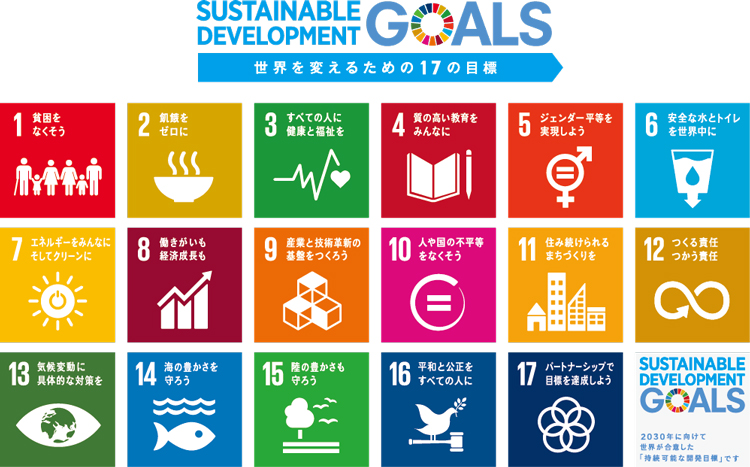
Achieving the Sustainable Development Goals (SDGs) with the use of Euglena
■Potential for Growth in SDGs and the Bio Market
SDGs, or Sustainable Development Goals, refer to the international objectives established in the '2030 Agenda for Sustainable Development,' adopted at the United Nations Summit in New York in September 2015. These goals consist of 17 themes, encompassing 169 targets, aiming to address issues such as poverty, hunger, and climate change from 2016 to 2030.
Within the goals of SDGs, there are numerous challenges where the field of biotechnology can contribute. In 2016, the Japan Bioindustry Association (JABEX) released its 'Vision for the Social Contribution of the Evolving Bioindustry in 2030,' highlighting the importance of the Japanese biotechnology sector in addressing the challenges posed by SDGs and the need for Japan to develop its own bioeconomy strategy.
The concept of a bioeconomy has been proposed internationally even before SDGs. The OECD predicts that the bioeconomy will account for 2.7% of GDP by 2030, with industry making up a significant portion. This has led to a new wave of acceleration in the bio market.

■Technological Innovation in the Field of Biotechnology and Smart Industry
According to the Industrial Structure Council of the Ministry of Economy, Trade and Industry, major technological innovations in the field of biotechnology include large-scale genome analysis using next-generation sequencers, IT x AI (bioinformatics) technology, and genome editing technology. It is believed that these technologies will play a crucial role in the future of biotechnology, allowing for the design and control of highly functional cells, referred to as 'smart cells.' The industrial application of these highly controlled biological cells is termed the 'smart cell industry.'
■Promoting the Development of Domestic Biomass Resources and the Smart Cell Industry
Microalgae, particularly Euglena, are considered promising domestic biomass resources. To achieve SDGs through the smart cell industry, selective breeding and modification of biological species suitable for domestic biomass production using biotechnology are essential. Our team has developed the world's first high-efficiency genome editing technology for Euglena. Additionally, basic research on gene function analysis and molecular breeding to improve the production capacity of useful substances in Euglena will enable the production of Euglena tailored for specific purposes. Applying these methods can make the use of Euglena-derived biofuels a reality—a crucial theme contributing to SDGs, particularly the goal of 'ensuring access to affordable, reliable, sustainable, and modern energy.'
■Challenges in Biofuels
To achieve one of the targets of SDGs, 'Take urgent and significant action to reduce the degradation of natural habitats, halt the loss of biodiversity, and protect and prevent the extinction of threatened species,' it is crucial to transition from petroleum resources to alternative fuels. The world's population is expected to exceed 9.7 billion by 2050, and natural oil resources are deemed insufficient to meet the consumption rates. Furthermore, the use of fossil fuels results in greenhouse gas emissions and, subsequently, global warming. Therefore, the development of clean energy sources has become a significant challenge. Various efforts are underway to utilize various biological resources as fuels.
In the United States, biofuels policy includes the approval of E15 fuel, which contains 15% bioethanol, for use in 90% of vehicles on the road. Additionally, regulations promoting the sale of high-ethanol-blend gasoline are being considered. While most U.S. bioethanol is produced from corn, there is concern about competition with existing uses of corn for food and livestock feed. A similar concern exists for sugarcane. As a result, alternative biofuels, particularly non-food crop-derived biofuels, are being promoted to avoid competition with other uses and reduce the potential for accelerated global warming due to expanded farmland.

■Achieving Biofuels Using Euglena gracilis
Euglena primarily stores glucose obtained through photosynthesis as 'paramylon,' a crystalline β-1,3-glucan, inside its cells. The amount of paramylon stored within the cells varies depending on cultivation conditions and growth periods, with it sometimes exceeding 50% of the dry weight.

When Euglena is placed in anaerobic conditions, paramylon is broken down into glucose, eventually converting into wax esters—an ester of fatty acids and fatty alcohols—inside the cells through a process called 'wax ester fermentation.' Unlike plant oils, which predominantly consist of components with carbon skeletons of 16 or more carbons, wax esters synthesized by Euglena are primarily composed of myristic acid (C14) and myristyl alcohol (C14). These shorter-chain lipids have lower melting points and hold promise as drop-in fuels.
■Practical Use of Euglena Wax Ester-Derived Biofuels
Euglena Co., Ltd. has been supplying conventional biodiesel fuel (DeuSEL®) derived from Euglena wax esters for use in company employee and visitor shuttle buses traveling between its Fujisawa factory and Shonandai Station in Kanagawa Prefecture. This experimental use has continued for over two years.
Furthermore, Euglena completed Japan's first bio-jet diesel fuel manufacturing demonstration plant in the Keihin Coastal Area of Tsurumi Ward, Yokohama City, in October 2018. The company aims to achieve paid flights using domestically produced bio-jet fuel by 2020 and has started supplying next-generation biodiesel fuel produced at the demonstration plant since the summer of 2019."


